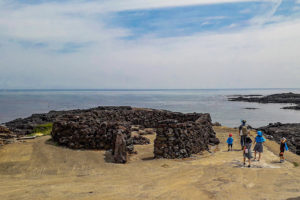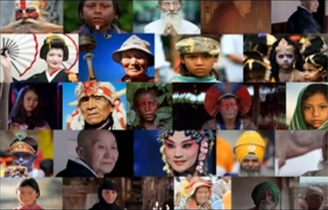Sumbi-sori Path, Life, and Beliefs of Women Divers in Jeju
 |
| Photos of Shamanistic rituals organized by women divers in Jeju, taken by Kim Soo-nam, exhibited at Sanjicheon Gallery ⓒ Jinhee Oh |
“Sumbi-sori is the sound of pain and the sound of life,” said Yun-bok Kim, a native Jeju islander whose deceased mother dedicated her entire life as a haenyeo, a female diver in Jeju.
Sumbi-sori is a huffing sound the diving women make upon exhaling after diving up to twenty meters. Kim said that his mother worked day and night, half on earth and half in the sea. He used to bring some food to his mother at dawn, when she was resting on a bulteok, a small, stone-walled structure built on the coast, where women divers can change into or out of their diving gear or gather around a fireplace to talk about their know-how and families. Kim remembers sweet grilled seaweed that his mother would make for him at the bulteok. “I didn’t really want to get up early and go to the bulteok, but now I miss the old days.”
On 25 May, I participated in a field trip program, Walk along the Haenyeo, organized by the Jeju Haenyeo Museum. I was excited to walk around the vast, crystal-clear ocean under the blue sky. About twenty participants walked for an hour and a half with Kim along Sumbi-sori Path, a trekking course in Sehwa-ri, which is home to the largest haenyeo community in Jeju with 280 female divers. Along the path, we could find agar harvested and dried on the ground, shrines built near the seaside to pray for the safety and a good harvest of haenyeo and fishermen, spring water as a source of drinking water for the village, field walls built with basalt rocks formed from volcanic activities, and bulteoks.
 |
| A bulteok at the seashore of Sehwa-ri in Jeju ⓒ Jinhee Oh |
Sumbi-sori Path was a good representation of haenyeo life. The women dive to pick various marine products, such as agar and seaweed, until May. Then, they stop harvesting when the spawning season starts in June. The work of the diving women never stops, however. During the spawning season that continues until August, they go back to their farms and plant seeds for carrots, potatoes, radishes, and other crops and harvest crops from winter to spring.
Currently, there are seventy-five shrines and thirty-five bulteoks that have been kept intact. Records show that there were five hundred shrines and temples in the 1700s. The number of haenyeo has dropped (4,300 today), and their average age has rapidly increased. The ocean is no longer something familiar to native Jeju islanders as well. They have noticed changes in the marine environment, which may not be noticeable by outsiders. Kim said, “It was easy to find conches and fish even at the seashore up until the 1940s and 50s, but this is not the case anymore.”
Meanwhile, Jeju’s haenyeo culture with hundreds of years of history was inscribed on UNESCO’s List of the Intangible Cultural Heritage of Humanity in 2016, because of its unique community-based lifestyles and eco-friendly values. Since the inscription, there has been an increase in exhibitions and programs aimed to introduce the haenyeo culture. This unique culture is valuable in that the diving women have devoted their lives to fishing with a strong sense of solidarity while trying to protect the marine environment that has provided livelihoods for the people there. The haenyeo culture has been recognized through photo and art exhibitions that present fishing practices, lifestyles, and traditional shamanic rituals of the women divers to safeguard and promote the practices and values.
Address: 81, Laiguangying West Road, Chaoyang District, Beijing, China
Zip Code: 100021
Tel: 86-10-64966526
Fax: 86-10-64969281
E-mail: administration@crihap.cn
NEWSLETTER
Leave us your e-mail address, we'll let you know about current events.


